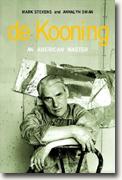Mark Stevens & Analyn Swan
book reviews:
· general fiction
· chick lit/romance
· sci-fi/fantasy
· graphic novels
· nonfiction
· audio books
· author interviews
· children's books @
curledupkids.com
· DVD reviews @
curledupdvd.com
newsletter
win books
buy online
links
home
for authors
& publishers
for reviewers

 |
De Kooning: An American Master Mark Stevens & Analyn Swan Knopf Hardcover 752 pages November 2004 |
|
Willem de Kooning painted big canvases that reflected the way he lived: large. He juggled up to five love affairs at one time (and kept them all secret from each other and his wife, Elaine, with a variety of code door knocks), out-painted his rivals such as Jackson Pollock, and was perhaps only happy drunk and asleep in a gutter. It was there, to riff on Wilde, that he saw the stars. De Kooning was the bohemian: part artist, part intellectual, part alcoholic playboy and pure adventuresome genius.
He finally made it big in 1948 with a show at the Egan Gallery. He bucked expectations—and Abstract Expressionism—by next producing a series of more or less figurative works, the Woman series. These scribbley, colorful and larger-than-life canvasses were inspired by his wife and solidified de Kooning’s reputation as an artist first among equals. “I might work on a painting for a month,” he said, “but it has to look like I painted it in a minute.” A New York minute, at that: spontaneous and confrontational, a collision of high and low, of the child-like and the anciently wise. De Kooning was a true student of art history: not of the books or the critics, but of the pictures themselves. He learned from and incorporated into his own works the styles of everyone from the painters of the walls of Lascaux to Picasso. As the critic Harold Rosenberg said, “If you had your own idea, that was it, you were stuck with it. The history of painting, however, contained endless inventions which the living painter could make his own. Even inventing a thing that had already been invented was an act of creation. De Kooning likes to call this ‘inventing the harpsichord’—the fact that we have the harpsichord, and even the piano that superseded it, does not prevent the invention that brought it into being from being legitimately repeated.” Stevens’ and Swan’s book is a delight for both art fans and gossip hounds, and it’s easy to see why it won the 2005 Pulitzer for biography. De Kooning was a wild man and he died the tragic death of the untamable. He lived a life that defied expectations and broke a lot of hearts. He painted a legacy that fills hearts and eyes with delight and wonder, and that will outlive us all. © 2005 by Brian Charles Clark for curledup.com. |
|
|
|
 Click here to learn more about this month's sponsor! |
|
| fiction · sf/f · comic books · nonfiction · audio newsletter · free book contest · buy books online review index · links · · authors & publishers reviewers |
|
| site by ELBO Computing Resources, Inc. | |
 He was born in Rotterdam in 1904 and stowed away to the U.S. in the mid-Twenties. He was already a master draughtsman and went to work in New York as a commercial artist and window dresser. He made a pretty good living that way. In the 1930s, though, he abandoned commercial art in favor of the more dangerous path: “pure” art. De Kooning quit his jobs at the height of the Depression and just in time to help formulate a major wave in American (and world) painting: Abstract Expressionism.
He was born in Rotterdam in 1904 and stowed away to the U.S. in the mid-Twenties. He was already a master draughtsman and went to work in New York as a commercial artist and window dresser. He made a pretty good living that way. In the 1930s, though, he abandoned commercial art in favor of the more dangerous path: “pure” art. De Kooning quit his jobs at the height of the Depression and just in time to help formulate a major wave in American (and world) painting: Abstract Expressionism.